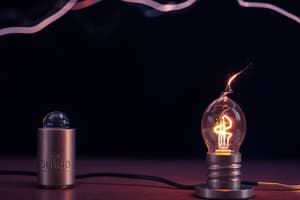Podcast
Questions and Answers
वैद्युत धारा को किस स्थिति में कहा जाता है?
वैद्युत धारा को किस स्थिति में कहा जाता है?
- जब वैद्युत आवेश स्थिर रहता है
- जब विद्युत धारा का प्रवाह शून्य होता है
- जब वैद्युत आवेश एक स्थान से दूसरे स्थान पर नहीं जाता
- जब वैद्युत आवेश एक स्थान से दूसरे स्थान पर प्रवाहित होता है (correct)
यदि किसी चालक में $t$ सेकंड में $q$ आवेश प्रवाहित हो, तो वैद्युत धारा का सूत्र क्या है?
यदि किसी चालक में $t$ सेकंड में $q$ आवेश प्रवाहित हो, तो वैद्युत धारा का सूत्र क्या है?
- $i = rac{q}{t}$ (correct)
- $i = rac{t}{q^2}$
- $i = rac{t}{q}$
- $i = q imes t$
कौन सा पदार्थ चालक कहलाता है?
कौन सा पदार्थ चालक कहलाता है?
- वो जिसमें विद्युत धारा नहीं बहती
- वो जिसमें केवल सकारात्मक आवेश होते हैं
- वो जो केवल गर्म होता है
- वो जिसमें विद्युत धारा उत्पन्न होती है (correct)
ओम का नियम किस स्थिति में लागू होता है?
ओम का नियम किस स्थिति में लागू होता है?
ओम के नियम की व्युत्पत्ति में किन चार तत्वों का उल्लेख किया गया है?
ओम के नियम की व्युत्पत्ति में किन चार तत्वों का उल्लेख किया गया है?
चालक में मुक्त इलेक्ट्रॉनों का घनत्व क्या दर्शाता है?
चालक में मुक्त इलेक्ट्रॉनों का घनत्व क्या दर्शाता है?
यदि तापमान में परिवर्तन होता है, तो ओम के नियम का क्या होता है?
यदि तापमान में परिवर्तन होता है, तो ओम के नियम का क्या होता है?
यदि तार की लम्बाई $l$ और परिच्छेद-क्षेत्रफल $A$ है, तो वैद्युत धारा $i$ का सूत्र क्या होगा?
यदि तार की लम्बाई $l$ और परिच्छेद-क्षेत्रफल $A$ है, तो वैद्युत धारा $i$ का सूत्र क्या होगा?
किस Kirchhoff के पहले नियम का सच या झूठ है?
किस Kirchhoff के पहले नियम का सच या झूठ है?
व्हीटस्टोन सेतु का प्रमुख उद्देश्य क्या है?
व्हीटस्टोन सेतु का प्रमुख उद्देश्य क्या है?
मीटर - सेतु का मुख्य लाभ क्या है?
मीटर - सेतु का मुख्य लाभ क्या है?
किस तत्व को Kirchhoff के दूसरे नियम में व्यक्त किया गया है?
किस तत्व को Kirchhoff के दूसरे नियम में व्यक्त किया गया है?
विभवमाषी का मुख्य उद्देश्य क्या है?
विभवमाषी का मुख्य उद्देश्य क्या है?
व्हीटस्टोन सेतु में धारामापी को कहाँ जोड़ा जाता है?
व्हीटस्टोन सेतु में धारामापी को कहाँ जोड़ा जाता है?
किस Kirchhoff के दूसरे नियम का सही व्याख्या है?
किस Kirchhoff के दूसरे नियम का सही व्याख्या है?
सर्वाधिक सुग्राही यन्त कौन सा है?
सर्वाधिक सुग्राही यन्त कौन सा है?
किस समीकरण को Kirchhoff के पहले नियम का जानकार माना जाता है?
किस समीकरण को Kirchhoff के पहले नियम का जानकार माना जाता है?
किस यन्त का मुख्य उपयोग विभवान्तर मापने के लिए किया जाता है?
किस यन्त का मुख्य उपयोग विभवान्तर मापने के लिए किया जाता है?
किस प्रकार के पदार्थों की प्रतिरोधकता ताप बढ़ने पर घटती है?
किस प्रकार के पदार्थों की प्रतिरोधकता ताप बढ़ने पर घटती है?
धातुओं की प्रतिरोधकता किस सीमा में होती है?
धातुओं की प्रतिरोधकता किस सीमा में होती है?
ओम के नियम की सीमाएँ क्या हैं?
ओम के नियम की सीमाएँ क्या हैं?
जिसे विद्युतरोधी कहा जाता है, उसकी प्रतिरोधकता कितनी होती है?
जिसे विद्युतरोधी कहा जाता है, उसकी प्रतिरोधकता कितनी होती है?
गतिशीलता को किस प्रकार परिभाषित किया जाता है?
गतिशीलता को किस प्रकार परिभाषित किया जाता है?
प्रतिरोधों के श्रृंखला में धारा का प्रवाह कैसा होता है?
प्रतिरोधों के श्रृंखला में धारा का प्रवाह कैसा होता है?
किस स्थिति में प्रतिरोधों का जोड़ समान्तर क्रम में होता है?
किस स्थिति में प्रतिरोधों का जोड़ समान्तर क्रम में होता है?
प्रतिरोध R किस प्रकार का होता है जब हम इसे बढ़ाते हैं?
प्रतिरोध R किस प्रकार का होता है जब हम इसे बढ़ाते हैं?
सेल का आंतरिक प्रतिरोध क्या है?
सेल का आंतरिक प्रतिरोध क्या है?
जब n सेलों को श्रेणी में जोड़ा जाता है, तो धारा का समीकरण क्या होता है?
जब n सेलों को श्रेणी में जोड़ा जाता है, तो धारा का समीकरण क्या होता है?
वैद्युत शक्ति P की परिभाषा क्या है?
वैद्युत शक्ति P की परिभाषा क्या है?
छोटी धातुकों की प्रतिरोधकता को कैसे वर्गीकृत किया जाता है?
छोटी धातुकों की प्रतिरोधकता को कैसे वर्गीकृत किया जाता है?
धातुओं के लिए क्या अवश्य होता है जब ताप बढ़ता है?
धातुओं के लिए क्या अवश्य होता है जब ताप बढ़ता है?
Flashcards
Ohm's Law
Ohm's Law
The current through a conductor between two points is directly proportional to the voltage across the two points.
Drift Velocity
Drift Velocity
Average velocity of charge carriers in a conductor due to an electric field.
Resistivity
Resistivity
Measure of material's opposition to current flow.
Resistance
Resistance
Signup and view all the flashcards
Mobility
Mobility
Signup and view all the flashcards
Series Resistors
Series Resistors
Signup and view all the flashcards
Parallel Resistors
Parallel Resistors
Signup and view all the flashcards
Internal Resistance
Internal Resistance
Signup and view all the flashcards
Electromotive Force (emf)
Electromotive Force (emf)
Signup and view all the flashcards
Electric Power
Electric Power
Signup and view all the flashcards
Series Cells
Series Cells
Signup and view all the flashcards
Parallel Cells
Parallel Cells
Signup and view all the flashcards
Electric Cell
Electric Cell
Signup and view all the flashcards
Conductivity
Conductivity
Signup and view all the flashcards
Electrical Energy
Electrical Energy
Signup and view all the flashcards
Ohm's Law Limits
Ohm's Law Limits
Signup and view all the flashcards
Kirchhoff's first law
Kirchhoff's first law
Signup and view all the flashcards
Kirchhoff's second law
Kirchhoff's second law
Signup and view all the flashcards
Wheatstone bridge
Wheatstone bridge
Signup and view all the flashcards
Meter bridge
Meter bridge
Signup and view all the flashcards
Potentiometer
Potentiometer
Signup and view all the flashcards
Equivalent Resistance (n Resistors in series)
Equivalent Resistance (n Resistors in series)
Signup and view all the flashcards
Equivalent Resistance (n Resistors in parallel)
Equivalent Resistance (n Resistors in parallel)
Signup and view all the flashcards
Post office box
Post office box
Signup and view all the flashcards
Potential difference
Potential difference
Signup and view all the flashcards
Electric current
Electric current
Signup and view all the flashcards
Electric Current
Electric Current
Signup and view all the flashcards
Electric Current Formula
Electric Current Formula
Signup and view all the flashcards
Conductor
Conductor
Signup and view all the flashcards
Ohm's Law
Ohm's Law
Signup and view all the flashcards
Ohm's Law Conditions
Ohm's Law Conditions
Signup and view all the flashcards
Derivation of Ohm's Law
Derivation of Ohm's Law
Signup and view all the flashcards
Drift Velocity
Drift Velocity
Signup and view all the flashcards
Charge Carriers
Charge Carriers
Signup and view all the flashcards
Study Notes
Chapter 3: Electric Current
- Electric Current: The flow of electric charge.
- Charge flow in a conductor: Electrons flow when a potential difference (voltage) is applied across it.
- Current (i): The rate of flow of charge. Measured in Amperes (A).
- i = Q/t (charge/time)
- Ohm's Law: The current through a conductor between two points is directly proportional to the voltage across the two points.
- V = IR (V is voltage, I is current, R is resistance)
- Resistance (R): A measure of how difficult it is for current to flow through a material. Measured in Ohms (Ω).
- Resistance depends on material, length, and cross-sectional area.
- Conductors: Materials with low resistance that allow current to flow easily.
- Insulators: Materials with high resistance that resist current flow.
- Semiconductors: Materials with intermediate resistance whose resistance can be controlled.
- Factors affecting resistance:
- Material
- Length of conductor
- Cross-sectional area
- Temperature
- Resistivity: A measure of a material's intrinsic resistance, dependent on the material.
- Temperature dependence of resistance: Resistance of a material changes with temperature. Generally, resistance increases with temperature.
- Electric power (P): Rate at which electrical energy is dissipated or used.
- P = VI (power equals volts times current)
- P = I²R (power equals current squared times resistance)
- P = V²/R (power equals volts squared divided by resistance)
Series Combination of Resistors
- Resistors in series: Resistors connected end-to-end in a single path.
- Total resistance (equivalent resistance): The sum of individual resistances
- Rtotal = R1 + R2 + ...
- Current is the same through all resistors.
- Voltage drops across resistors add up to the total voltage.
Parallel Combination of Resistors
- Resistors in parallel: Resistors connected between the same two points (multiple paths).
- Equivalent resistance: 1/Rtotal = 1/R1 + 1/R2 + ...
- Current is divided amongst parallel resistors.
- Voltage is the same across all parallel resistors.
Kirchhoff's Laws
- Kirchhoff's Current Law (KCL): The total current entering a junction equals the total current leaving it.
- Kirchhoff's Voltage Law (KVL): The sum of voltage drops around any closed loop in a circuit equals the sum of the voltage rises.
- The voltage drops across each resistor must equal the voltage supplied by the sources around each closed loop.
Electric Cells and EMF
- Electromotive force (EMF): The energy provided by a cell per unit of charge to drive electrical current when the circuit is open. (EMF= voltage provided by cell to drive circuit)
- Internal resistance: Resistance within a cell that opposes the flow of current.
Wheatstone Bridge
- Wheatstone bridge: A circuit used to measure an unknown resistance.
- Principle: This principle is based on conditions for the null deflection of a galvanometer, that is when no current flows through the galvanometer.
Studying That Suits You
Use AI to generate personalized quizzes and flashcards to suit your learning preferences.
Related Documents
Description
इस प्रश्नोत्तरी में विद्युत धारा के सिद्धांतों का परीक्षण करें। इसमें धारा, ओम का नियम और प्रतिरोध के कारक जैसे महत्वपूर्ण विषय शामिल हैं। सही उत्तर देकर अपने ज्ञान को मजबूत करें और विद्युत प्रवाह की अवधारणाओं को समझें।




